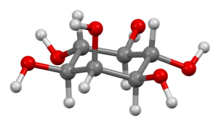Inositol

| |

| |

| |
| Names | |
|---|---|
| IUPAC name
myo-Inositol
| |
| Systematic IUPAC name
(1R,2S,3r,4R,5S,6s)-Cyclohexane-1,2,3,4,5,6-hexol | |
| Other names
cis-1,2,3,5-trans-4,6-Cyclohexanehexol
Cyclohexanehexol Mouse antialopecia factor Nucite Phaseomannite Phaseomannitol Rat antispectacled eye factor Scyllite (for the isomer scyllo-inositol) Vitamin B8 | |
| Identifiers | |
3D model (
JSmol ) |
|
| ChEBI | |
| ChEMBL | |
| ChemSpider | |
ECHA InfoCard
|
100.027.295 |
IUPHAR/BPS |
|
| KEGG | |
PubChem CID
|
|
| UNII | |
CompTox Dashboard (EPA)
|
|
| |
| |
| Properties | |
| C6H12O6 | |
| Molar mass | 180.16 g/mol |
| Density | 1.752 g/cm3 |
| Melting point | 225 to 227 °C (437 to 441 °F; 498 to 500 K) |
| Pharmacology | |
| A11HA07 (WHO) | |
| Hazards | |
| NFPA 704 (fire diamond) | |
| Flash point | 143 °C (289 °F; 416 K) |
Except where otherwise noted, data are given for materials in their standard state (at 25 °C [77 °F], 100 kPa).
| |
Inositol, primarily the
It is a
Inositol is promoted as a dietary supplement in the management of polycystic ovary syndrome (PCOS). However, there is only evidence of very low quality for its efficacy in increasing fertility for IVF in women with PCOS.[6]
Overview
myo-Inositol plays an important role as the structural basis for a number of
Inositol or its phosphates and associated lipids are found in many foods, in particular fruit, especially cantaloupe and oranges.[7] In plants, the hexaphosphate of inositol, phytic acid or its salts, the phytates, serve as phosphate stores in seed, for example in nuts and beans.[8] Phytic acid also occurs in cereals with high bran content. Phytate is, however, not directly bioavailable to humans in the diet, since it is not digestible. Some food preparation techniques partly break down phytates to change this. However, inositol in the form of glycerophospholipids, as found in certain plant-derived substances such as lecithins, is well absorbed and relatively bioavailable.
myo-Inositol (free of phosphate) was once considered a member of the
Isomers and structure
myo-Inositol is the biologically important form of cyclohexane-1,2,3,4,5,6-hexol. It is a
In its most stable
Biosynthesis
In humans, myo-Inositol is
At the peripheral level, myo-inositol is converted to D-chiro-inositol by a specific epimerase. Only a minor fraction of myo-inositol is converted into D-chiro-inositol.[3] The activity of this epimerase is insulin dependent, causing a reduction of D-chiro-inositol in muscle, fat, and liver when there is insulin resistance.[12][3] D-chiro-inositol reduces the conversion of testosterone to estrogen, thereby increases the levels of testosterone and worsening PCOS.[3]
Phytic acid in plants

Inositol hexaphosphate, also called
Inositol penta- (IP5), tetra- (IP4), and triphosphate (IP3) are also called "phytates".
Biological function
Inositol, phosphatidylinositol and some of their mono- and polyphosphates function as secondary messengers in a number of intracellular signal transduction pathways. They are involved in a number of biological processes, including:
- Insulin signal transduction[17]
- Cytoskeleton assembly
- Nerve guidance (epsin)
- Cell membrane potential maintenance[19]
- Breakdown of fats[20]
- Gene expression[21][22]
In one important family of pathways, phosphatidylinositol 4,5-bisphosphate (PIP2) is stored in cellular membranes until it is released by any of a number of signalling proteins and transformed into various secondary messengers, for example diacylglycerol and inositol triphosphate.[23]
Industrial uses
Explosives industry
At the 1936 meeting of the American Chemical Society, professor Edward Bartow of the University of Iowa presented a commercially viable means of extracting large amounts of inositol from the phytic acid naturally present in waste corn. As a possible use for the chemical, he suggested 'inositol nitrate' as a more stable alternative to nitroglycerin.[24] Today, inositol nitrate is used to gelatinize nitrocellulose in many modern explosives and solid rocket propellants.[25]
Road salt
When plants are exposed to increasing concentrations of
Research and clinical applications
Psychiatry
Depression
Large doses of inositol have been studied for treatment of depression, but further study is needed to determine whether this is an effective treatment.[27]
Panic disorder and obsessive-compulsive disorder
Inositol has been found to have modest to moderate effects in patients with
Trichotillomania
High doses of inositol are sometimes used to treat trichotillomania (compulsive hair-pulling) and related disorders,[30] but a small (N=38) double-blinded placebo-controlled trial did not find a statistically significant improvement with inositol.[31]
Other illnesses
D-chiro-inositol is an important messenger molecule in insulin signaling.[32] Inositol supplementation has been shown to significantly decrease triglycerides and LDL cholesterol in patients with metabolic diseases.[32]
myo-Inositol is important for thyroid hormone synthesis.[33] Depletion of myo-inositol may predispose to development of hypothyroidism.[33] Patients with hypothyroidism have a higher demand for myo-inositol than healthy subjects.[33]
Inositol should not be routinely implemented for the management of preterm babies who have or are at a risk of
Inositol is considered a safe and effective treatment for polycystic ovary syndrome (PCOS).[36] It works by increasing insulin sensitivity, which helps to improve ovarian function and reduce hyperandrogenism.[37] It is also shown to reduce the risk of metabolic disease in women with PCOS.[38] In addition, thanks to its role as FSH second messenger, myo-inositol is effective in restoring FSH/LH ratio and menstrual cycle regularization.[39] myo-Inositol's role as FSH second messenger leads to a correct ovarian follicle maturation and consequently to a higher oocyte quality. Improving the oocyte quality in both women with or without PCOS, myo-inositol can be considered as a possible approach for increasing the chance of success in assisted reproductive technologies.[40][41] In contrast, D-chiro-inositol can impair oocyte quality in a dose-dependent manner.[42] The high level of DCI seems to be related to elevated insulin levels retrieved in about 70% of PCOS women.[43] In this regard, insulin stimulates the irreversible conversion of myo-inositol to D-chiro-inositol causing a drastic reduction of myo-inositol. myo-Inositol depletion is particularly damaging to ovarian follicles because it is involved in FSH signaling, which is impaired due to myo-inositol depletion.[12] Recent evidence reports a faster improvement of the metabolic and hormonal parameters when these two isomers are administered in their physiological ratio. The plasmatic ratio of myo-inositol and D-chiro-inositol in healthy subjects is 40:1 of myo- and D-chiro-inositol respectively.[44] The use of the 40:1 ratio shows the same efficacy of myo-inositol alone but in a shorter time. In addition, the physiological ratio does not impair oocyte quality.[45]
The use of inositols in PCOS is gaining more importance, and an efficacy higher than 70% with a strong safety profile is reported. On the other hand, about 30% of patients could show as inositol-resistant.[46] New evidence regarding PCOS aetiopathogenesis describes an alteration in the species and the quantity of each strain characterizing the normal gastrointestinal flora. This alteration could lead to chronic, low-level inflammation and malabsorption.[47] A possible solution could be represented by the combination of myo-inositol and α-lactalbumin. This combination shows a synergic effect in increasing myo-inositol absorption.[48] A recent study reported that the myo-inositol and α-lactalbumin combination is able to increase myo-inositol plasmatic content in inositol-resistant patients with a relative improvement of hormonal and metabolic parameters.[49]
Despite its antinutrient effect, phytic acid has potential uses in endodontics, adhesive, preventive, and regenerative dentistry, and in improving the characteristics and performance of dental materials.[50]
Use as a cutting agent
Inositol has been used as an adulterant or
Inositol is also used as a stand-in
Nutritional sources
myo-Inositol is naturally present in a variety of foods, although tables of food composition do not always distinguish between
myo-Inositol can also be found as an ingredient in energy drinks,[57] either in conjunction with or as a substitute for glucose.[58]
In humans, myo-inositol is naturally made from glucose-6-phosphate through enzymatic dephosphorylation.[54]
References
- ^ Merck Index (11th ed.). p. 4883.
- ^ PMID 17121280.
- ^ PMID 33755975.
- ^ "What Is Inositol?". Cleveland Clinic. Retrieved 2024-04-10.
- PMID 23764390.
- PMID 30570133.
- ^ S2CID 4442333.
- ^ "Phytic acid". www.phytochemicals.info. Archived from the original on 2017-08-06. Retrieved 2017-10-02.
- ISBN 978-0-85369-300-0.
An isomer of glucose that has traditionally been considered to be a B vitamin although it has an uncertain status as a vitamin has not been identified in man
- ISBN 9780387276007.
- ISBN 9780080472072.
- ^ PMID 21641593.
- ^ "Phytic acid". www.phytochemicals.info. Archived from the original on 7 March 2018. Retrieved 2018-05-02.
- ^ Klopfenstein, T. J.; Angel, R.; Cromwell, G.; Erickson, G. E.; Fox, D. G.; Parsons, C.; Satter, L. D.; Sutton, A. L.; Baker, D. H. (July 2002). "Animal diet modification to decrease the potential for nitrogen and phosphorus pollution". Council for Agricultural Science and Technology. 21. Archived from the original on 2011-06-11.
- PMID 12949395.
- ISBN 978-0-309-02117-3.
- PMID 11900279.
- PMID 17074764.
- PMID 9017197.
- PMID 3103610.
- S2CID 8381889.
- PMID 12434012.
- OCLC 42290721.
- ^ Laurence, W. L. (April 17, 1936). "Corn by-product yields explosive". The New York Times. p. 7. Archived from the original on 2013-05-12.
- ISBN 9780615142906.
- S2CID 9128286.
- PMID 15106232.
- PMID 7793450.
- PMID 8780431.
- PMID 30892151.
- S2CID 3273619.
- ^ PMID 29793496.
- ^ PMID 34040582.
- PMID 31283839.
- PMID 28243254.
- PMID 36703143.
- S2CID 24836559.
- PMID 22774396.
- S2CID 24582338.
- PMID 21744744.
- PMID 19800728.
- PMID 22587479.
- PMID 27510482.
- PMID 26479434.
- S2CID 45611717.
- S2CID 24469378.
- PMID 22178787.
- S2CID 13691602.
- PMID 29747700.
- .
- ^ "Inositol, Nerve guidance, Cutting agent manufacturer". Tianyu Feed Additive. Archived from the original on 2014-09-08. Retrieved 2013-07-21.
- ^ Golianopoulos, T. (2012-05-12). "Drug doubles: What actors actually toke, smoke and snort on camera". Wired. Archived from the original on 2012-05-14. Retrieved 2012-05-14.
- ^ How Fake Drugs Are Made For Movies | Movies Insider, retrieved 2022-09-26
- ^ a b Awuchi, Chinaza (2017). "Sugar Alcohols: Chemistry, Production, Health Concerns and Nutritional Importance of Mannitol, Sorbitol, Xylitol, and Erythritol". International Journal of Advanced Academic Research. 5 (11): 1954–1967.
- PMID 25946551.
- PMID 24529702.
- PMID 31112702.
- ^ DiSalvo, David. "We Know About Caffeine in Energy Drinks Like Monster, But What About the Other Ingredients?". Forbes. Retrieved 2020-12-22.









